 Inflation is a key macroeconomic variable and governments typically aim for both low and stable rates of inflation. In the UK there are two main measures of the rate of inflation in the UK – the CPI and the RPI. Over the past few years there has been a growing gap between the two measures and this has led to consultations about how the RPI could be adapted to allow it to rise more slowly in the future. (Click here for a PowerPoint of the chart.)
Inflation is a key macroeconomic variable and governments typically aim for both low and stable rates of inflation. In the UK there are two main measures of the rate of inflation in the UK – the CPI and the RPI. Over the past few years there has been a growing gap between the two measures and this has led to consultations about how the RPI could be adapted to allow it to rise more slowly in the future. (Click here for a PowerPoint of the chart.)
The RPI and CPI measure inflation in different ways – they don’t measure the same basket of goods. The RPI measure includes the costs of housing, whereas the CPI does not include this. Furthermore, the RPI is an arithmetic mean and the CPI is a geometric mean, which will be lower than the arithmetic mean. The ONS says that a key advantage of using the geometric mean (i.e. the CPI) is that:
…it can better reflect changes in consumer spending patterns relative to changes in the price of goods and services.
Typically the RPI has been about 1% higher than the CPI and governments can benefit from this by linking state benefits to the CPI (the lower rate) and payments they receive to the RPI, thus maximising the difference between earnings and expenditure.
However, the gap between these two measures of inflation has been growing and this has been causing concern for the ONS and the Office for Budget Responsibility (OBR). This has led to the consultative process regarding making changes to the RPI. However, any change made to the RPI would put certain groups at a disadvantage. One such group is pensioners – many pensioners in the private sector have their pensions linked to the RPI and if a change were made to bring it more in line with the CPI (i.e. lower it) they would suffer. Ros Altman, director general of SAGA said:
After 30 years of retirement, someone who receives 0.6% lower inflation uprating will end up with a pension nearly 20% lower…Therefore, over time, pensioners will be able to afford less and less and pensioner poverty will increase once again.
There would be some beneficiaries of any change to the RPI – the government would benefit in some areas; company pension schemes might also see gains made; some students might benefit and even rail travellers.
An announcement was made by the National Statistician, Jil Matheson, on the 10 January. Much to the surprise of most experts, she has decided to keep the RPI measure unchanged. She did recommend, however, that a new index be introduced that would be published alongside RPI and CPI. The new index would better meet international standards.
The following articles look at the arguments for and against changing the RPI measure.
Articles prior to announcement
Pensioner backlash expected over pension reform The Telegraph, Philip Aldrick (9/1/13)
Inflation: Changes to the calculation of RPI expected BBC News (9/1/13)
RPI review ‘may hit pensioners’ Express and Star (9/1/13)
Q&A: Inflation changes BBC News (9/1/13)
Pension holders and savers: beware of an RPI inflation change The Economic Voice (9/1/13)
Pensioners and savers face ‘stealth attack’ on their income from change to the inflation index Mail Online (9/1/13)
Articles following announcement
Relief for pensions as ONS says leave RPI unchanged The Telegraph (10/1/13)
RPI review recommends new inflation index The Guardian (10/1/13)
Inflation: No change to RPI calculation BBC News, 10/1/13)
The ONS puts consistency first BBC News, Stephanie Flanders (10/1/13)
Q&A: Inflation changes BBC News (10/1/13)
Announcement by National Statistician
National Statistician announces outcome of consultation on RPI ONS (10/1/13)
Questions
- How are the RPI and CPI measured?
- Why is the RPI typically higher than the CPI?
- What changes to the RPI were suggested? What are the advantages and disadvantages of each?
- Who would have benefited from each of the proposed changes to the RPI?
- Who would have suffered from each of the proposed changes to the RPI?
- Why has there been a growing divergence between the two measures of inflation?
- Do interest rates affect the RPI and CPI measures of inflation to the same extent?
- Which measure of inflation is used for the Bank of England’s inflation target? Has it always been the measure used?
 Pressure has been growing in the UK for people to be paid no less than a living wage. The Living Wage Foundation claims that this should be £8.55 per hour in London and £7.45 in the rest of the UK. The current minimum wage is £6.19.
Pressure has been growing in the UK for people to be paid no less than a living wage. The Living Wage Foundation claims that this should be £8.55 per hour in London and £7.45 in the rest of the UK. The current minimum wage is £6.19.
There has been considerable support for a living wage across the political spectrum. Ed Miliband, the Labour leader, has stated that a Labour government would ensure that government employees were paid at least the living wage and that government contracts would go only to firms paying living wages. Other firms that paid less could be ‘named and shamed’. The living wage has also been supported by Boris Johnson, Conservative Mayor of London. The Prime Minister said that a living wage is ‘an idea whose time has come’, although many Conservatives oppose the idea.
The hourly living wage rate is calculated annually by the Centre for Research in Social Policy and is based on the basic cost of living. The London rate is calculated by the Greater London Authority.
Advocates of people being paid at least the living wage argue that not only would this help to reduce poverty, it would also help to reduce absenteeism and increase productivity by improving motivation and the quality of people’s work.
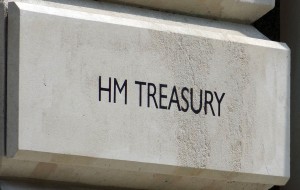 It would also bring in additional revenue to the government. According to a report by the Institute for Public Policy Research and the Resolution Foundation, if everyone were paid at least a living wage, this would increase the earnings of the low paid by some £6.5bn per year. Of this, some £3.6bn would go to the government in the form of higher income tax and national insurance payments and reduced spending on benefits and tax credits. Of this £6.5bn, an extra £1.3 billion would be paid to public-sector workers, leaving the Treasury with a net gain of £2.3bn.
It would also bring in additional revenue to the government. According to a report by the Institute for Public Policy Research and the Resolution Foundation, if everyone were paid at least a living wage, this would increase the earnings of the low paid by some £6.5bn per year. Of this, some £3.6bn would go to the government in the form of higher income tax and national insurance payments and reduced spending on benefits and tax credits. Of this £6.5bn, an extra £1.3 billion would be paid to public-sector workers, leaving the Treasury with a net gain of £2.3bn.
But what would be the effect on employment? Would some firms be forced to reduce their workforce and by how much? Or would the boost to aggregate demand from extra consumer spending more than offset this and lead to a rise in employment?. The following articles look at the possible effects.
Articles
Living wage for all workers would boost taxes and GDP Independent, Nigel Morris (28/12/12)
Living wage could save £2bn – think tank research BBC News (28/12/12)
‘Living wage’ would save money, says study Financial Times, Helen Warrell (28/12/12)
Why the Resolution Foundation and IPPR can go boil their heads Adam Smith Institute, Tim Worstall (30/12/12)
Living wage for public servants moves a step closer The Observer,
Yvonne Roberts and Toby Helm (15/12/12/)
Living wage: Ed Miliband pledge over government contracts BBC News (5/11/12)
‘London Living Wage’ increased to £8.55 by mayor BBC News (5/11/12)
Q&A: The living wage BBC News (5/11/12)
Scrooges in UK firms must pay a Living Wage This is Money, John Sentamu (23/12/12)
Report
What price a living wage? IPPR and The Resolution Foundation, Matthew Pennycook (May 2012)
Questions
- How would you set about determining what the living wage rate should be?
- Distinguish between absolute and relative poverty. Would people being paid below a living wage be best described as absolute or relative poverty (or both or neither)?
- What do you understand by the term ‘efficiency wage’? How is this concept relevant to the debate about the effects of firms paying a living wage?
- Under what circumstances would raising the statutory minimum wage rate to the living wage rate result in increased unemployment? How is the wage elasticity of demand for labour relevant to your answer and how would this elasticity be affected by all firms having to pay at least the living wage rate?
- What would be the macroeconomic effects of all workers being paid at least the living wage rate? What would determine the magnitude of these effects?
 If aggregate demand were to expand, would there be sufficient spare capacity to allow aggregate supply to expand to meet the additional demand? This is the question addressed by the podcast and article below.
If aggregate demand were to expand, would there be sufficient spare capacity to allow aggregate supply to expand to meet the additional demand? This is the question addressed by the podcast and article below.
If there is plenty of spare capacity, policies to increase aggregate demand could help to take up the slack and thereby achieve economic growth – at least as long as spare capacity remains. In other words, in the short run the aggregate supply curve may be horizontal or only gently upward sloping at the current point of intersection with the aggregate demand curve. This is illustrated by point a in the diagram. A rightward shift in the aggregate demand curve would cause a movement along the aggregate supply curve to a new higher level of real national income (Y).
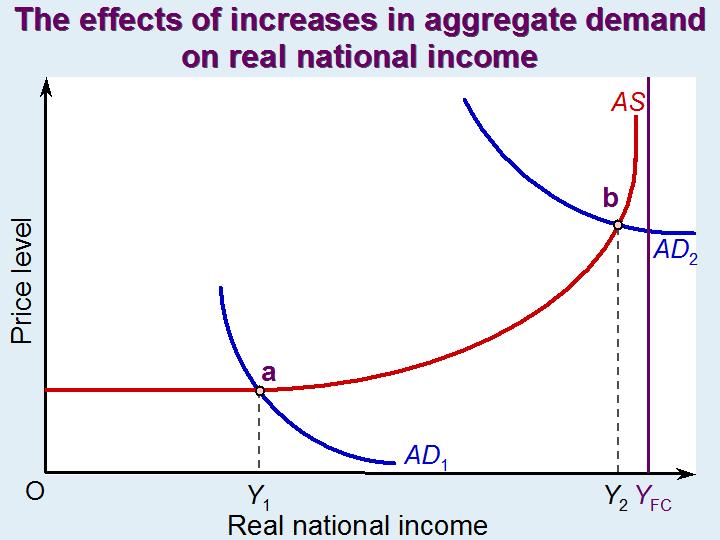
If, however, there is little or no spare capacity, an increase in nominal aggregate demand is likely to be purely inflationary, or virtually so. This would the case at point b in the diagram. Real national income cannot expand beyond the full-capacity level, YFC. Under such circumstances, any attempt by the government to stimulate economic growth should focus on the supply side and attempt to shift the aggregate supply curve to the right. Examples of supply-side policy include incentives to encourage research and development, incentives for the private sector to invest in new capacity and direct public investment in infrastructure.
Unemployment is not just caused by a lack of aggregate demand relative to aggregate supply. It may be the result of a mismatching of labour supply with the demand for labour. People may have the wrong qualifications or not be where the jobs are. Unemployment may co-exist with quite high levels of vacancies. There may be vacancies for highly qualified scientists, technicians or craftspeople and unemployment of people with low skills or skills no longer in high demand. The same may apply to capital equipment. There may be a shortage of high-tech equipment or equipment to produce goods in high demand and redundant older equipment or equipment in areas of declining demand.
Part of a comprehensive set of policies to tackle unemployment and achieve economic growth would be to focus on the whole balance of the economy and the matching of the demand and supply of inputs.
Podcast
 Is there ‘spare capacity’ in the economy? BBC Today Programme, Evan Davis and Andrew Sentance (4/12/12)
Is there ‘spare capacity’ in the economy? BBC Today Programme, Evan Davis and Andrew Sentance (4/12/12)
Article
OBR’s supply pessimism could be the ruin of this government The Telegraph, Roger Bootle (25/11/12)
Data
Claimant count and vacancies dataset ONS (14/11/12)
Labour Market Statistics, November 2012 ONS (14/11/12)
Actual weekly hours worked ONS (14/11/12)
Usual weekly hours worked ONS (14/11/12)
Questions
- Distinguish between ‘unemployment’, ‘underemployment’ and ‘disguised unemployment’?
- To what extent does the level of unemployment provide a good measure of spare capacity?
- Is the UK economy suffering from a deflationary gap? If so, how would you measure the size of that gap?
- If there is substantial spare capacity, is expansionary fiscal policy the best means of achieving economic growth?
- What policies are likely to have both a positive supply-side effect and a positive demand-side effect?
- What constraints does the government face in attempting to boost aggregate demand?
- Why might policies designed to stimulate aggregate demand also increase supply capacity?
- What policies would you recommend for tackling the mismatching of the demand and supply of inputs?
 In a previous blog, Anyone got a crystal ball?, we reported on the Bank of England’s and other agencies’ difficulty in making forecasts. As the Governor, Mervyn King, said, “There is just enormous uncertainty out there.”
In a previous blog, Anyone got a crystal ball?, we reported on the Bank of England’s and other agencies’ difficulty in making forecasts. As the Governor, Mervyn King, said, “There is just enormous uncertainty out there.”
The Bank of England has just published its November Inflation Report. This quarterly publication gives forecasts of inflation, GDP and other indicators. It is clear that forecasting hasn’t become any easier. In his opening remarks, Dr. King says:
Continuing the recent zig-zag pattern, output growth is likely to fall back sharply in Q4 as the boost from the Olympics in the summer is reversed – indeed output may shrink a little this quarter. It is difficult to discern the underlying picture. It is probably neither as good as the zigs suggest nor as bad as the zags imply.
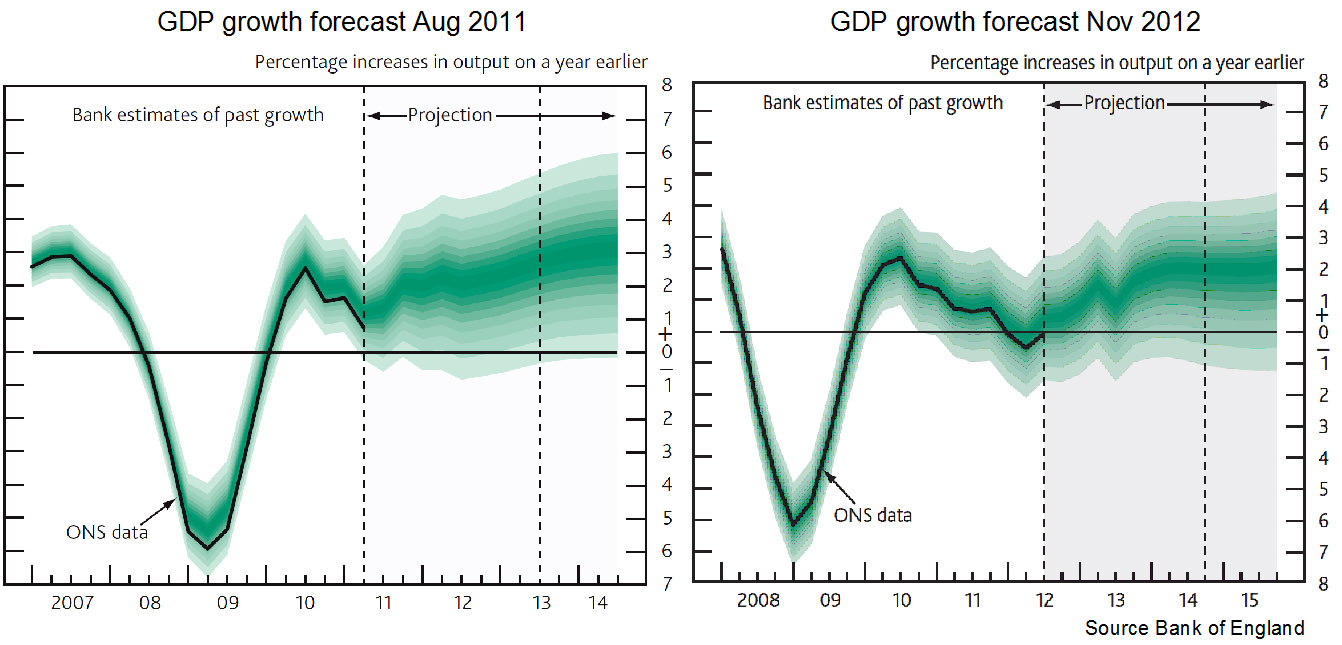
The Inflation Report looks at the various factors affecting aggregate demand, inflation, unemployment and aggregate supply. It is quite clear on reading the report why there is so much uncertainty.

A salutary lesson is to look back at previous forecasts and see just how wrong they have been. The chart above shows the forecasts for GDP made in the Inflation Reports of Nov 2012 and Aug 2011. You can see that they are significantly different and yet just 15 months apart. You might also like to compare the forecasts made a year ago (or even two!) about 2012 with the actual situation today. A good source for this is the Treasury’s Forecasts for the UK economy. This collates the forecasts from a range of independent forecasters.
The inaccuracy of forecasting is an inevitable consequence of a highly interdependent world economy that is subject to a range of economic shocks and where confidence (or lack of it) is a major determinant of aggregate demand. But when firms, governments, individuals and central banks have to make plans, it is still necessary to project into the future and try to forecast as accurately as possible – even though it might mean keeping your fingers firmly crossed.
Articles
Bank of England downgrades growth forecast for 2013 Daily Record (14/11/12)
A gloomy picture from the Old Lady Financial Times (14/11/12)
Will Britain’s post-recession economy be resurgent, stagnant or greener? The Guardian, Larry Elliott (11/11/12)
Economics must heed political risk Financial Times, Sebastian Mallaby (6/11/12)
European Commission autumn forecast: overoptimistic and in denial Social Europe Journal, Andrew Watt (7/11/12)
Bank of England gets long to-do list for overhaul Reuters, Sven Egenter (2/11/12)
Data
Inflation Report, November 2012 Bank of England
Index of economic forecasts European Commission DGECFIN
Economic Outlook Annex Tables OECD
World Economic Outlook Reports IMF
Forecasts for the UK economy HM Treasury
Questions
- What was being forecast for economic growth and inflation for 2012 (a) one year ago; (b) two years ago?
- What are the main reasons for the inaccuracy of forecasts?
- How might forecasting be made more reliable?
- If sentiment is a key determinant of economic activity, how might politicians increase the confidence of firms and consumers? What are the political constraints on doing this?
- Explain the following statement from the Guardian article: “The problem … is that last decade’s tailwind has become this decade’s headwind.” Why is it difficult to forecast the strength of this ‘headwind’?
- How useful is it to use past trends as a guide to the future course of the economy?
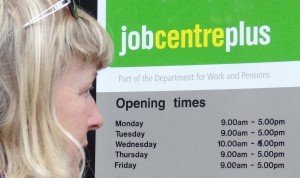 UK Unemployment figures for the July to September period have just been published. Perhaps surprisingly, the rate has fallen to 7.8% from 8.0% in the previous 3-month period. What is more, there have been similar 0.2 percentage-point falls in each of the two 3-month periods prior to that (see chart below).
UK Unemployment figures for the July to September period have just been published. Perhaps surprisingly, the rate has fallen to 7.8% from 8.0% in the previous 3-month period. What is more, there have been similar 0.2 percentage-point falls in each of the two 3-month periods prior to that (see chart below).
This would normally suggest that the economy has been growing strongly and faster than the growth in potential output. But, despite positive economic growth in quarter 3 (see A positive turn of events?), the economy has been experiencing a prolonged period of low or negative growth.
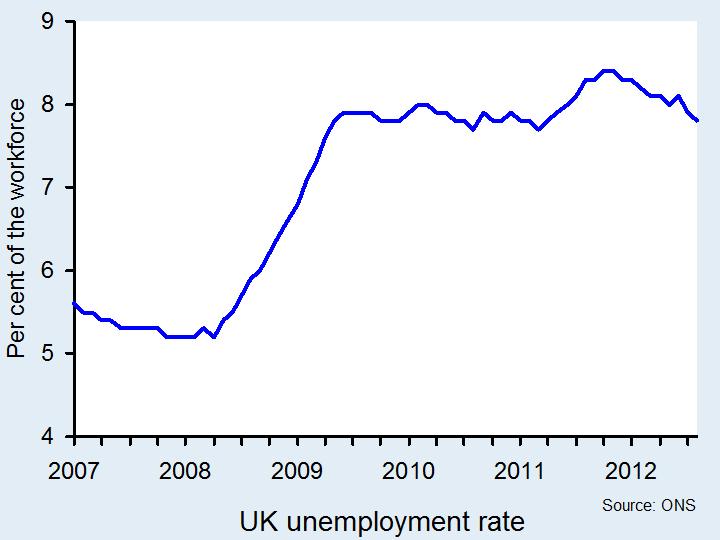
So what is the explanation for the fall in unemployment? (For a PowerPoint of the chart, click here)
One reason is a greater flexibility in the labour market than in previous recessions. People are more willing to accept below inflation wage increases, or even nominal wage cuts, in return for greater job security. Others are prepared to reduce their hours.
The other reason is a fall in productivity (i.e. output per hour worked). One explanation is that people are not working so hard because, with a lack of demand, there is less pressure on them to be productive; a similar explanation is that firms are ‘hoarding’ labour in the hope that the market will pick up again.

Another explanation is that employment growth has often occurred in the low productivity industries, such as labour-intensive service industries; another is that when people leave their jobs they are replace by less productive workers on lower wages; another is that workers are making do with ageing equipment, whose productivity is falling, because firms cannot afford to invest in new equipment. An range of possible explanations is given on page 33 of the Bank of England’s November 2012 Inflation Report.
But with many predicting that growth will be negative again in 2012 quarter 4, the fall in unemployment may not continue. Britain may join many other countries in Europe and experience rising unemployment as well as falling output.
Articles
Government hails fall in jobless total The Guardian, Hélène Mulholland (14/11/12)
UK unemployment figures: analysis The Guardian, Larry Elliott (14/11/12)
Jobless claims rise as Olympics effect wanes The Telegraph, Rachel Cooper and Louisa Peacock (14/11/12)
UK unemployment falls to 2.51 million, ONS says BBC News (14/11/12)
 Unemployment continuing to fall BBC News, Stephanie Flanders (14/11/12)
Unemployment continuing to fall BBC News, Stephanie Flanders (14/11/12)
Britain’s recession: Harsh but fair? BBC News, Stephanie Flanders (17/10/12)
The UK productivity puzzle (cont’d) BBC News, Stephanie Flanders (20/9/12)
UK jobs: The plot thickens BBC News, Stephanie Flanders (15/8/12)
Data
Unemployment: the key UK data and benefit claimants for every constituency Guardian Data Blog
Labour Market Statistics, November 2012 ONS
 Video Summary: Latest on the Labour Market, November 2012 ONS
Video Summary: Latest on the Labour Market, November 2012 ONS
Labour Productivity, Q2 2012 ONS
International Comparisons of Productivity, First estimates for 2011 ONS
Questions
- What possible explanation are there for the latest fall in unemployment?
- What has been happening to employment, both full time and part time?
- What are the different ways of measuring productivity? Why will they be affected differently by a fall in the average number of hours worked?
- Why might it be in firms’ interests to maintain the level of their workforce despite falling sales?
- Assume that there has been a fall in aggregate demand. Compare the resulting effect on consumption of (a) a fall in wages rates; (b) a rise in unemployment. How might the design of the benefit system affect the answer?
 Inflation is a key macroeconomic variable and governments typically aim for both low and stable rates of inflation. In the UK there are two main measures of the rate of inflation in the UK – the CPI and the RPI. Over the past few years there has been a growing gap between the two measures and this has led to consultations about how the RPI could be adapted to allow it to rise more slowly in the future. (Click here for a PowerPoint of the chart.)
Inflation is a key macroeconomic variable and governments typically aim for both low and stable rates of inflation. In the UK there are two main measures of the rate of inflation in the UK – the CPI and the RPI. Over the past few years there has been a growing gap between the two measures and this has led to consultations about how the RPI could be adapted to allow it to rise more slowly in the future. (Click here for a PowerPoint of the chart.)









